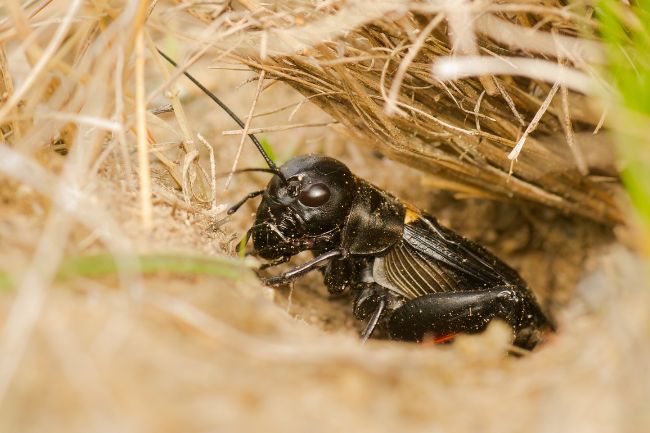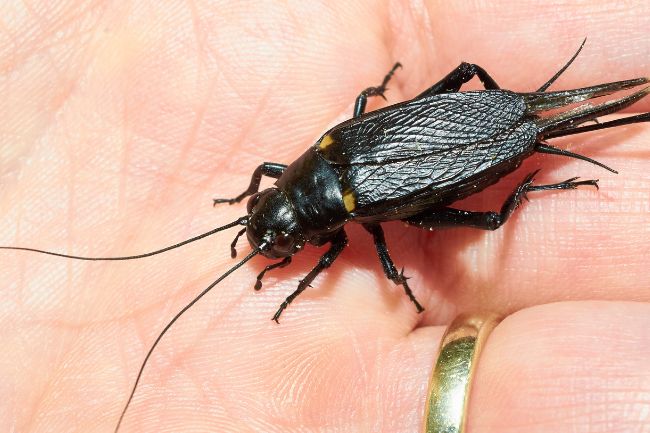Most cricket species are nocturnal, being active at night, though some are diurnal. Light is important to them as it helps them regulate their daily life cycle, however they can live without it.
Humans have introduced large amounts of artificial light into the natural world. Understanding how light affects a cricket’s life cycle is important to ensure they are not disturbed by human activity.
Also read: Centipedes at Night: What Do They Do & Why Do They Prefer it!
Light as a Natural Cue

Natural light is very important to many wild animals, as it helps to set their circadian rhythm. A circadian rhythm is a nature cycle our bodies are tuned in to to help regulate when we’re awake and asleep.
Although for humans, this rhythm is keyed in to waking us up in the day and letting us sleep at night, for crickets the opposite is true. For a cricket the presence of light indicates they should be in bed. Therefore it light is present at night they may not become as active as they would in the dark.
Natural Lighting Conditions in the Habitats of Crickets
As most crickets are nocturnal, the amount of light available in the day doesn’t really matter to them. What is important is the presence of light at night, as this can prevent them from becoming active, as they believe it is day.

The presence of artificial light at night can cause crickets to stop chirping. Chirping is a way for males to attract females to mate, meaning they lose the opportunity to produce offspring. Over time this can reduce the cricket population where artificial light is present at night.
Not all crickets experience light. Some cricket species spend their lives in caves, meaning they aren’t exposed to daylight.
| Light Condition | Cricket Behavior | Observations |
|---|---|---|
| Natural Daylight | Increased activity, foraging | Crickets become active and engage in foraging behaviors during daylight hours, moving around to search for food and interact with their environment. |
| Artificial Lighting | Disorientation, attracted to light | Crickets may show confusion and disorientation under artificial lighting, with some being drawn towards light sources, often congregating near them. |
| Moonlight | Reduced activity, mating calls | Crickets tend to exhibit reduced overall activity during moonlit nights, often focusing on mating calls and interactions with potential mates. |
| Darkness | Resting, reduced movement | In complete darkness, crickets typically reduce their movement and enter a resting state, conserving energy and limiting activity levels. |
Also read: Cricket’s Wings and Their Flight Capabilities
Impact of Lighting on Crickets Kept in Controlled Environments
In captivity it is important to include darkness within the daily cycle. For most cricket species it won’t matter if you invert the night and day, as long as they have enough time with and without light so they can be active and inactive during a 24 hour period.
Some artificial lights can attract crickets to them, such as LED lights on the blue end of the spectrum. These can confuse crickets, and cause them to move towards the light.
Also read: Moths & Lights – Why Do They Attract Them?
Lighting for Activity and Reproduction
The presence of light during the nighttime has been found to disrupt mating activities. Crickets may still become active in artificial light, but without successful mating, they can soon be lost from an area.
Lighting and Circadian Rhythms
Circadian rhythms are like a natural internal clock that helps many animals to regulate their activities throughout the day and throughout seasons. This clock also affects them physically, with the body naturally adapting to different times of the day.
Crickets are also believed to live their lives by circadian rhythms, which are guided by the light they detect with their simple eyes. If light is no longer present it is likely this internal clock may become less accurate over time.
Also read: The Diversity of What Crickets Eat
Recommended Lighting Options for Pet Crickets

Crickets can be reared without light without any negative impacts on the animal’s wellbeing. They can also be reared with artificial or natural light. The main requirement for crickets is that they are able to experience darkness for at least 12 hours a day, in order to carry out their natural lifecycle without issues.
While most forms of artificial light are suitable for crickets, it’s important to remember some lighting also gives out heat, which may negatively affect crickets in captivity.
| Light Intensity | Cricket Activity |
|---|---|
| High Intensity | Increased movement, foraging |
| Moderate Intensity | Balanced activity levels |
| Low Intensity | Reduced movement, inactivity |
| Complete Darkness | Minimal to no movement |
Frequently Asked Questions
- Do crickets require light to survive?
Crickets do not need light to survive, and can spend all their time in darkness without any negative effects. - What are the ideal lighting conditions for pet crickets?
Crickets can be kept in complete darkness or can be exposed to light for a similar length of time as they would in their natural environment. - Can crickets be exposed to artificial light sources?
Crickets can live in artificially lit conditions, however, they do not like strong lighting, and need to be kept in a suitable temperature, with some bulbs potentially creating too much heat to be safe to use. - How many hours of light do crickets need each day?
Crickets do not need any amount of light to survive, and cam happily live in the dark. - What happens if crickets are deprived of light?
Crickets are nocturnal and are therefore active at night. If deprived of light the times they become active may change, however it won’t be detrimental to their lifecycle.

Also read: Cricket Hydration and Water Needs
Conclusion
Crickets are largely nocturnal, and can be negatively affected by the intrusion of artificial light. Bright light can result in them no longer chirping, and reduce the likelihood of successful breeding
Both wild and captive crickets can be negatively affected by artificial light. In the wild artificial lights can illuminate the night, resulting in wild crickets being disturbed and disrupted in the life cycles.
In captivity it’s important that lighting isn’t too bright and is absent for at least half the day. This way the crickets can lead a more natural life within captivity.
It may seem strange to us, but for many species light is highly disruptive and disorientating when it invades the darkness. It’s important therefore we limit artificial light wherever possible, and allow the darkness to remain unspoiled for all of those that love it.

